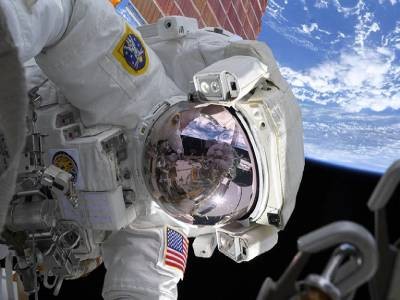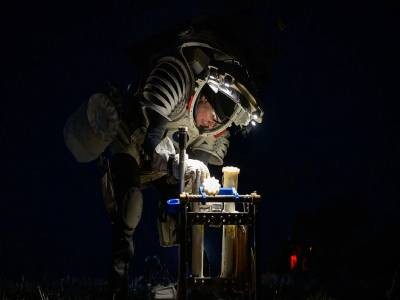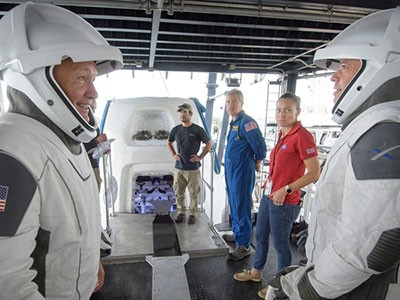Hayley Arceneaux had plenty to worry about before journeying into space for the first time. Her health history was unusual for a space traveller: she would be the first childhood cancer survivor to enter Earth’s orbit, and the first with a prosthetic — a metal rod standing in for a cancerous segment of bone that had been removed from one leg.
Astronauts have conducted nearly 3,000 science experiments aboard the ISS
But on the morning before lift-off in September 2021, she felt strangely calm. “I kept thinking, ‘When am I going to get nervous?’” she says. “The 9-minute ride to space — I was just having the time of my life.”
Arceneaux is a sign of what’s to come, as companies such as SpaceX, based in Hawthorne, California, ferry more and more civilians to space on massively expensive commercial flights. For decades, the health effects of space travel have been mapped by studying professional astronauts, many of whom trained mentally and physically for years to get the job. A suite of scientific reports published on 11 June now aims to chart how spaceflight affects space tourists with a wider variety of health histories.
The studies show that just a few days in orbit can cause immune-cell disruption, dehydration and cloudy thinking — but that most of these conditions revert to normal soon after the travellers return to Earth.
Taken together, the 44 reports — written by authors at more than 25 countries and 100 institutions — comprise the largest catalogue of data detailing space travel’s impact on the human body1. “This is the beginning of precision medicine for spaceflight,” says Christopher Mason, a geneticist at Weill Cornell Medicine in New York City, who is a co-author on some of the papers. “Let’s bring the full armamentarium of modern molecular biologist tools to bear for these crews who are regular people.”
A ‘strange environment’
Most of the data on the health effects of spaceflight have so far been collected from white men aged 30 years old and beyond, many with a military background, says Mathias Basner, an epidemiologist who studies astronaut behavioural health at the University of Pennsylvania Perelman School of Medicine in Philadelphia, and a co-author on some of the papers. Little is known about how other groups of people will respond to the unique stresses of spaceflight, including radiation exposure and microgravity.
Exclusive: How NASA astronauts are training to walk on the Moon in 2026
That means that the risks could be higher. “Space is a very strange environment,” says Basner.
On the other hand, commercial spaceflights also launch more often than governmental ones, run by national space agencies such as NASA, do. So, on the plus side, researchers can collect data more quickly than before — and potentially from a more diverse population, Basner adds.
Among the latest studies are some evaluating the health of the crew of SpaceX’s 2021 Inspiration4 flight, which was the first all-civilian spaceflight to orbit Earth. The four passengers on that flight, including two men and two women — one of whom was Arceneaux — ranged from ages 29 to 51 years old.
For the roughly three days that they were in orbit, Arceneaux and her crewmates collected saliva, urine and blood samples, conducted ultrasounds on themselves, took cognitive tests and wore fitness trackers2. Researchers assessed those specimens and data and found some physiological changes that had previously been registered only on longer spaceflights. These included alterations in immune-cell function, and a lengthening of telomeres, the caps at the end of chromosomes.

The crew of Inspiration4 (from left) were avionics engineer Chris Sembroski, geoscientist and artist Sian Proctor, billionaire businessman Jared Isaacman and physician’s assistant and childhood cancer survivor Hayley Arceneaux.Credit: Inspiration4 crew/John Kraus
However, about 95% of the changes reverted soon after the crew landed, Mason says. Some of the remaining changes persisted for at least three months after landing, suggesting a longer recovery period.
With data from only four people, it is difficult to draw firm conclusions about the effects of spaceflight on civilians. Where possible, the researchers compared their results with data from astronauts that worked with NASA or the Japan Aerospace Exploration Agency. They also drew upon data from mice and cell cultures that were grown in space, exposed to radiation or grown in microgravity.
When you see the same biomarker levels rising over and over again across three different missions and three different sets of people, “that’s when you start believing it”, says Afshin Beheshti, a systems biologist at the Blue Marble Space Institute of Science in Seattle, Washington, and a co-author on several of the studies.
A spaceflight catalogue
Mason and his colleagues developed a database called the Space Omics and Medical Atlas (SOMA) to collect this and future health information from civilian space travellers and professional astronauts, as well as a biobank to store their samples. These, along with the wide range of data collected from Inspiration4, are exciting developments for the field, says Susan Bloomfield, a systems physiologist who studies the biological effects of spaceflight at Texas A&M University in College Station.
SpaceX to launch astronauts — and a new era of private human spaceflight
But Bloomfield would like to see more demographic details, such as age, sex and past medical history, included in these and future publications that use the SOMA database. Although privacy concerns have limited the release of such information in the past, Bloomfield argues that it is important for researchers to have access to data that could help to ensure the safety of future space travellers. Mason notes that SOMA contains such data, but cannot release it publicly.
It’s a surprise that the Inspiration4 flight — a relatively short trip — prompted some of the same physiological changes seen in astronauts who have been on much longer missions, says Catherine Yeung, a pharmacist who studies the effects of spaceflight on people’s kidneys at the University of Washington in Seattle. Gathering more of this data could help researchers to design interventions that mitigate or at least predict the effects of spaceflight on the body, for both civilians and astronauts alike, says Basner.
For example, someone’s data might point to them being at particular risk for severe motion sickness in space, he says, and knowing that could allow physicians to provide a treatment — or at least advise the person to avoid going altogether. “If you’re going to spend three days vomiting in a bag, you might not want to pay US$10 million for that ticket.”




